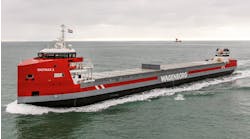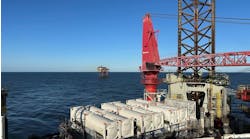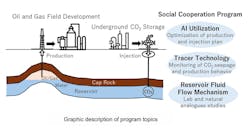Implementation of offshore CCS requires a multidisciplinary approach
Editor's note: This Beyond the Horizon column first appeared in the May-June 2024 issue of Offshore magazine. Click here to view the full issue.
By Paul Bansil, KBR Consulting International
Carbon capture and storage (CCS) is an effective way to lower greenhouse gas emissions from offshore facilities by a large amount. But using CCS in offshore projects is not easy. There are many technical challenges that need to be solved to make these projects successful.
If offshore CCS technology is to undergo wider adoption, all projects must minimize the overall cost of capturing, transporting and storing CO2. This includes reducing the expense of using offshore reservoirs for storage, optimizing process and pipeline design, and selecting the most appropriate materials for construction.
One of the key strategies for achieving cost-effectiveness is to de-crew the platform during normal operation (i.e. eliminate personnel on the asset) thereby reducing the equipment required on the offshore platform. This involves carefully assessing all activities and items of equipment that will require maintenance and reliability, and ideally eliminating them where possible. By running the platform as leanly as possible operators can significantly reduce the costs associated with maintaining and operating the CCS facility.
Offshore CCS projects present a range of unique safety risks that must be carefully managed to protect personnel and equipment. One of the most significant risks is the potential for CO2 leaks or discharges, which can have severe consequences for human health and safety.
CO2 is a toxic gas, which can cause hazards to personnel at lower concentrations in air than would suffocate them. In some vent/release conditions, the CO2 could result in low temperatures and potential for freezing injuries, as well as poor visibility. In the event of a leak or discharge, personnel on the offshore platform could be exposed to dangerous levels. To mitigate this risk, CCS facilities must be designed with robust safety measures in place, including strategically placed venting systems that direct CO2 away from personnel and advanced detection and alarm systems that can alert workers to potential hazards.
The selection and operation of equipment for offshore CCS projects presents a range of technical challenges that must be carefully considered. Compressors, for example, are critical components of the CCS process, responsible for pressurizing the CO2 for transport and storage. However, reaching the required pressures can be challenging.
A way of meeting these challenges is to utilize expertise in cryogenic systems to develop tailored solutions for offshore CCS projects. This includes selecting and designing compressors, as well as other equipment, that can handle the high pressures and low temperatures associated with CO2 compression, while maintaining optimal performance and reliability.
Other equipment, such as valves and seals, must also be carefully selected to ensure that they can withstand the unique conditions of the CCS process. This requires an in-depth understanding of the properties of CO2 and the application of advanced engineering principles in equipment design and selection.
The design and commissioning of pipelines for transporting CO2 from the offshore platform to the storage reservoir presents another set of technical challenges that must be addressed. One of the key issues is preventing water ingress into the system during the linking of pipeline sections.
Identifying and characterizing suitable storage reservoirs is a critical aspect of offshore CCS projects. These reservoirs must be capable of securely storing CO2 over long periods.
The use of depleted hydrocarbon reservoirs for storing CO2 is challenging due to the potential for hydrocarbons potentially flowing back up the injection well into the CCS facility. A risk assessment will identify whether there is a likelihood of hydrocarbons being present, which would determine whether appropriate controls and measures need to be implemented.
Using advanced geologic modelling and simulation techniques to characterize the reservoir and identify any potential risks is a key way of addressing this challenge. This method includes evaluating factors such as reservoir geology, seal integrity, and storage capacity.
Once a suitable storage site has been identified, it is possible to develop robust monitoring and verification systems to ensure the long-term safety and effectiveness of the storage solution. This includes using specialized technologies to track the movement of the injected CO2 and detect any potential leaks or migration pathways.
The implementation of offshore CCS projects requires a multidisciplinary approach that combines expertise in process engineering, pipeline design, equipment selection, and geologic characterization.
As the world continues to address the need to reduce greenhouse gas emissions, offshore CCS will play an increasingly important role in the transition to a low-carbon economy. By addressing the technical challenges associated with these projects, the offshore oil and gas industry can position itself as an industry that is doing what it can to address climate change, while also ensuring the long-term viability of its operations.




